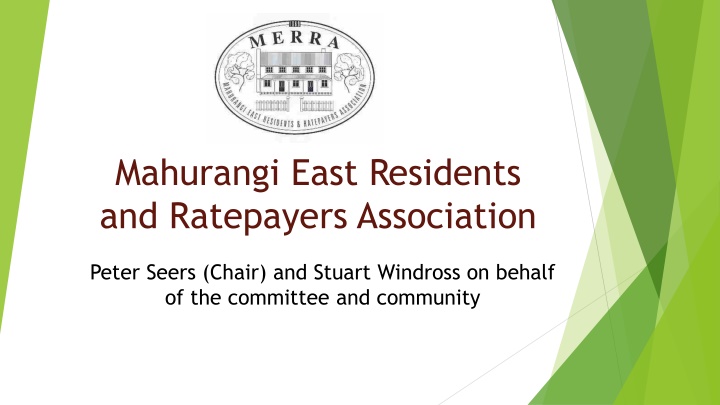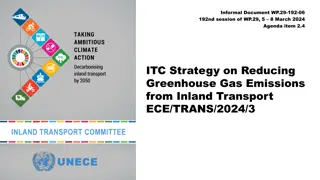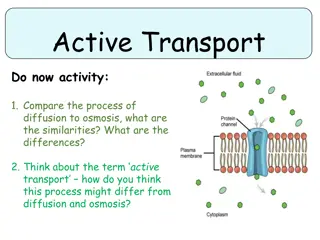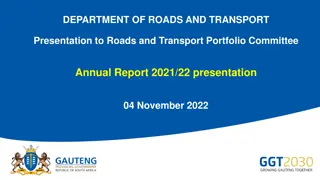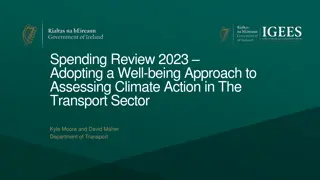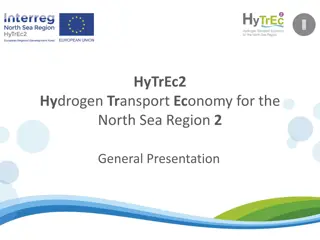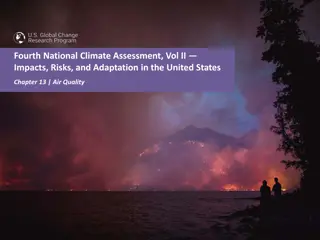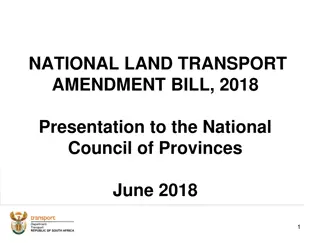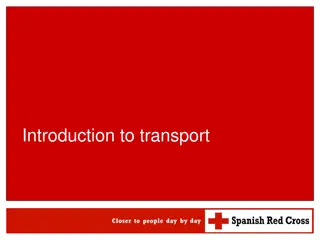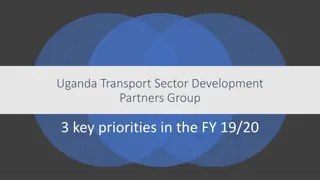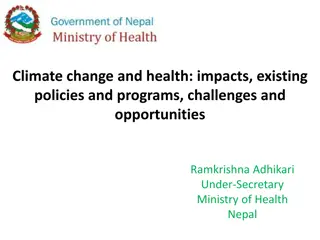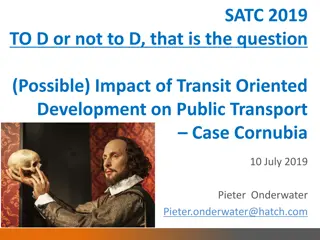Community Submission on Transport Impacts & Climate Concerns
MERRA represents a coastal community advocating for environmental initiatives and transport network efficiency. This submission focuses on reducing CO2 emissions, addressing traffic congestion, and promoting alternative transport options. Quotes from Auckland Council and Waste Management highlight the importance of climate action and prioritizing road investments. Referencing key policies and plans, MERRA emphasizes the need to align with national and regional goals in the consent process.
Download Presentation

Please find below an Image/Link to download the presentation.
The content on the website is provided AS IS for your information and personal use only. It may not be sold, licensed, or shared on other websites without obtaining consent from the author.If you encounter any issues during the download, it is possible that the publisher has removed the file from their server.
You are allowed to download the files provided on this website for personal or commercial use, subject to the condition that they are used lawfully. All files are the property of their respective owners.
The content on the website is provided AS IS for your information and personal use only. It may not be sold, licensed, or shared on other websites without obtaining consent from the author.
E N D
Presentation Transcript
Mahurangi East Residents and Ratepayers Association Peter Seers (Chair) and Stuart Windross on behalf of the committee and community
Introduction: MERRA represents the coastal community around Scotts Landing on the Mahurangi Harbour. MERRA s many community initiatives include extensive environmental planting and pest/weed control programmes in partnership with Auckland Council. Our community is dependent on SH1 north. It is our connection to the rest of NZ. It is our sole connection to critical services and infrastructure including hospitals and airports This is a community submission; well canvassed over 2 years and strongly supported by our community and others groups in the area.
This submission does NOT support consent MERRA specifically supports those submitting on leachate/water quality and related concerns and defers to their expertise Beyond that MERRA also seeks to protect the safe and efficient operation of the transport network MERRA focusses particularly on climate change/Co2 emissions, road safety, traffic congestion and amenity. Contrary to the AEE we argue the proposal does have significant transport impacts and that these extend well beyond the proposed landfill site and its immediate environs. We assert there is an alternative transport option that has been dismissed lightly and prematurely
Two quotes bookend our submission: AUCKLAND COUNCIL on Climate Change/Co2 Emissions: By unanimously voting to declare a climate emergency we are signalling the council s intention to put climate change at the front and centre of our decision making, Mayor Phil Goff 11 June 2019 WASTE MANAGEMENT on Traffic Congestion: Auckland congestion is a major drag on productivity and quality of life AT and NZTA need to prioritise investment in road and heavy rail if not the adverse impact on the ability to move goods and services and flow on effects will be intolerable WMNZ Director Tom Nickels, NZ Herald 3 October 2018
MERRA also refers you (for example) to: Paris Agreement on Climate Changeand NZ s obligations as signatory Government Policy Statement on Land Transport NZ Rail Plan Auckland Council s Low Carbon Strategic Action Plan andTe Taruke-a- Tawhiri: Auckland s Climate Plan (July 2020)* Auckland Transport s Road Transport Management Planand Regional Land Transport Plan Goals that therefore should be front and centre in this consent process include: Reducing Co2 Emissions (to net zero by 2050) Halving Auckland s greenhouse emissions by 2030* Reducing traffic congestion via alternative transport modes Reducing road fatalities Moving freight from road to rail (and coastal shipping) Committed land transport Crown funding 2021/2 2022/3 2023/4 2024/5 New Zealand Upgrade Programme - Rail $313,390,000 $244,370,000 $93,490,000 $22,900,000
MERRA refutes the AEEs conclusion that the potential REGIONAL traffic effects of the proposed landfill will be no more than minor We are talking here 740+ extra (mostly diesel) vehicle movements per day on SH1 and through the notorious Dome Valley well over 520 of these movements (most ex urban Auckland) will be heavy vehicles each round trip will be approximately 120 kilometres a 60% increase in SH1/Dome Valley heavy vehicle movements a daily fuel burn of 14,000 litres (producing 38 tonnes of Co2 daily)
MERRA further submits that the applications Assessment of Environmental Effects and specifically the Integrated Transport Assessment (Stantec, May 2019) is both inadequate and flawed FOR EXAMPLE: Failure to reference NZ s international, national and regional agreements, policies and plans Failure to adequately assess the potential of adjacent North Auckland Rail Line (c2km from site) and recent Government- funded upgrades. Rail transport is dismissed lightly and prematurely in the application (especially given the $85m + $109m upgrades recently announced). Analysis of a rail transport option is inexplicably invisible in the Integrated Transport Assessment A myopic focus on the safety, operation and projected delays at the proposed new roundabout at the entrance to the landfill site
Failure to address effects across the wider transport network eg: resultant emission, congestion, amenity and safety impacts ITA silent on Co2 emissions (rail could reduce by >66%) ITA silent on accidents/fatalities (rail could reduce by c95%) ITA silent on health effects. (Ironically the AEE addresses emissions, noise, dust, vibration, etc at the proposed ARL site but NOT related to its massive transport footprint) Failure to consider the future impact of the new Puhoi to Warkworth motorway on the balance of SH1 / SH16 peak-traffic volumes and the consequent impact on Dome Valley tailbacks Failure to provide a detailed Section 92 assessment of the impact of additional (slower) heavy vehicles post the Dome Valley safety improvements (eg removal of passing lanes, safety barrier enclosure). The response does little more than state It is acknowledged that the increase in heavy vehicles will have some impact on traffic flows and speeds What some is is NOT quantified.
A focus on vehicle counts while ignoring delay times or tailbacks (paradoxically upstream elements (ie congestion) is mentioned only once in the ITA and solely as a mitigation for the forecast delays at the proposed new access roundabout) Questionable data on the proportional increase in heavy vehicles over both current and 2026-8 background numbers. Our analysis using WMNZ and NZTA figures varies significantly from that presented by Stantec. (60-44% MERRA vs 12-13% Stantec) See MERRA s footnote 18 & Stantec s S92 Jan 2020. Questionable traffic data modelling. Ill-timed August (winter) data is extrapolated to model summer/holiday peaks by cross referencing an NZTA count that excludes the significant unquantified volume of traffic that diverts to/from Mangawhai/Te Arai via Wayby Valley Rd just north of the site
WMNZs Section 92 response indicates peak landfill traffic on Saturdays. Saturday SH1 tailbacks and delays in excess of an hour are already routine on weekends even outside summer peaks. The ITA is silent on these delays. MERRA argues that tailbacks will be shifted north from 2022 and without a rail option will be greatly exacerbated There is a failure to discuss or define a specific transport-phasing mechanism to mitigate peak traffic impacts There is no consideration of vehicle limits (perhaps sinking-lid) that could align with and incentivise rail transport initiatives over time (Note that vehicle limits are a condition of Whitford Landfill consent)
Conclusion: Climate change isn t an infrastructure problem what we need is behavioural change with clear leadership from (Local) Government Paul Winton Investment Consultant (NZ Herald 13 Nov 2020) transport emissions need to fall 64% to achieve the goal of 50% reduction in Auckland s total emissions by 2030 doing what we have always done ain tgoing to touch the sides Auckland Transport CEO Shane Ellison (NZ Herald 17&13 Nov 2020) MERRA submits that this application is more of the same , blind to its time, and unacceptable. It fails to capitalise on one of the best prospects for getting massive freight volumes off road and onto rail we will see in a lifetime. Rail is right there. Waste is an ideal rail cargo: bulk, homogeneous, single destination, non-time-critical
A rail transport option would bring an ARL saving in Co2 emissions of >66%, decrease road safety risks by up to 95%, and remove hundreds of heavy vehicles daily from the SH1/Dome Valley congestion and road safety equations We remind the commissioners of WMNZ s stance and face to face assurance to MERRA that they are committed to considering rail as a future option MERRA submits that as it stands this application be declined Failing that MERRA submits that transporting waste by rail become a condition of consent. (If necessary incentivised by a daily limit/sinking lid on heavy vehicle movements) We urge a strongly policy-aligned, forward-looking and symbolic decision for the future of Auckland, for road users and for the planet
